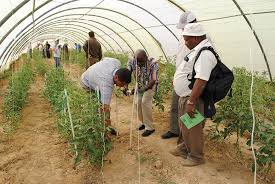
Subsurface Irrigation: Saving Water and Boosting Crop Yields
Share
🚰 Subsurface Irrigation: A Water-Saving Farming Revolution
With growing concerns about water scarcity and the need for sustainable agriculture, modern irrigation methods have become essential for efficient farming. One such method gaining popularity is subsurface irrigation — a technique that not only conserves water but also boosts crop productivity. Whether you're a commercial farmer or an agricultural enthusiast, understanding this system can help you make smarter, more sustainable decisions in crop production.
🌿 What Is Subsurface Irrigation?
Subsurface irrigation (SSI) is a water-saving irrigation technique where water is delivered directly to the root zone of plants through a network of pipes or drip lines buried beneath the soil surface. This method ensures that water goes exactly where it's needed — reducing evaporation, runoff, and deep percolation losses.
There are two main types of subsurface irrigation:
- Passive SSI: Uses natural water table movements.
- Active or Controlled SSI (SDI - Subsurface Drip Irrigation): Uses buried emitters or pipes to deliver controlled amounts of water.
The most common form in modern agriculture is Subsurface Drip Irrigation (SDI).
🧠 How Subsurface Irrigation Works
In SDI systems, flexible polyethylene tubes or PVC pipes with tiny holes or emitters are installed 10–50 cm below the soil surface, depending on the crop. These emitters release water slowly and directly into the soil around plant roots. The system can be powered manually, electrically, or via solar energy, and is often automated using sensors and timers.
✅ Benefits of Subsurface Irrigation
💧 1. Significant Water Savings
Water is applied below the surface, so evaporation losses are minimized. In dry or hot climates, this can result in up to 30–50% water savings compared to surface irrigation or traditional drip irrigation.
🌱 2. Enhanced Crop Yields
By delivering water directly to the roots, plants receive consistent moisture, which reduces stress and promotes uniform growth. Better root health often leads to higher yields and improved crop quality.
🦠 3. Reduced Weed Growth and Disease
Since the soil surface remains relatively dry, weed seeds are less likely to germinate. Additionally, leaf diseases that thrive in humid environments are reduced, as the plant canopy stays dry.
⚙️ 4. Efficient Fertilizer Use (Fertigation)
Subsurface systems can be integrated with fertigation, delivering nutrients along with water. This ensures targeted nutrition, reduces waste, and minimizes environmental runoff.
🧑🌾 5. Labor and Time Savings
Automated SSI systems reduce the need for manual watering, which saves labor and time — especially beneficial for large-scale farms.
🌍 6. Environmentally Friendly
Lower water usage, reduced chemical runoff, and decreased energy consumption make subsurface irrigation a more sustainable farming practice.
🌾 Ideal Crops for Subsurface Irrigation
- Subsurface irrigation can be used for a variety of crops, including:
- Vegetables: Tomatoes, peppers, onions, lettuce, carrots
- Field crops: Corn, alfalfa, cotton, sugarcane
- Orchards and vineyards: Grapes, citrus, pomegranate
- Turfgrass: Golf courses, parks, sports fields
- It’s especially suitable for areas with limited water resources and sandy or loamy soils that drain well.
Explore our full product collection here to find irrigation solutions and crop care essentials.
⚠️ Challenges and Considerations
💸 1. High Initial Investment
The installation of pipes, filters, emitters, and control systems can be expensive. However, the long-term savings in water and labor often justify the cost.
🔧 2. System Maintenance
Clogged emitters, root intrusion, or pipe damage can reduce system efficiency. Regular flushing and filtering are necessary to maintain performance.
📏 3. Proper Design Required
Designing the system for your specific crop, soil type, and topography is essential. Poor design can lead to uneven water distribution or over/under-watering.
🔍 4. Difficult to Monitor
Since everything is underground, it's harder to visually inspect for problems. Using moisture sensors and monitoring tools is highly recommended.
💡 Tips for Successful Implementation
- Conduct a soil and crop suitability study before installation.
- Hire a professional designer or use certified tools for layout and installation.
- Start small — test the system on a portion of your field first.
- Integrate sensors to track soil moisture and water delivery.
- Schedule regular maintenance to prevent blockages and damage.
- Use high-quality filtration systems to reduce the risk of emitter clogging.
🧠 Final Thoughts
Subsurface irrigation is a forward-thinking solution for the future of agriculture. With the growing demand for water-efficient practices, SSI stands out as a method that supports both sustainability and profitability. It offers a win-win situation — conserving precious water while increasing crop productivity.
While it may require an initial investment and some planning, the long-term benefits of better water management, healthier crops, and reduced operational costs make subsurface irrigation a smart choice for modern growers.
If you're serious about water conservation and want to boost your crop yields sustainably, it's time to explore our offerings or get in touch with us for more expert advice.
Also, don’t forget to follow us on YouTube for product updates and tutorials.
